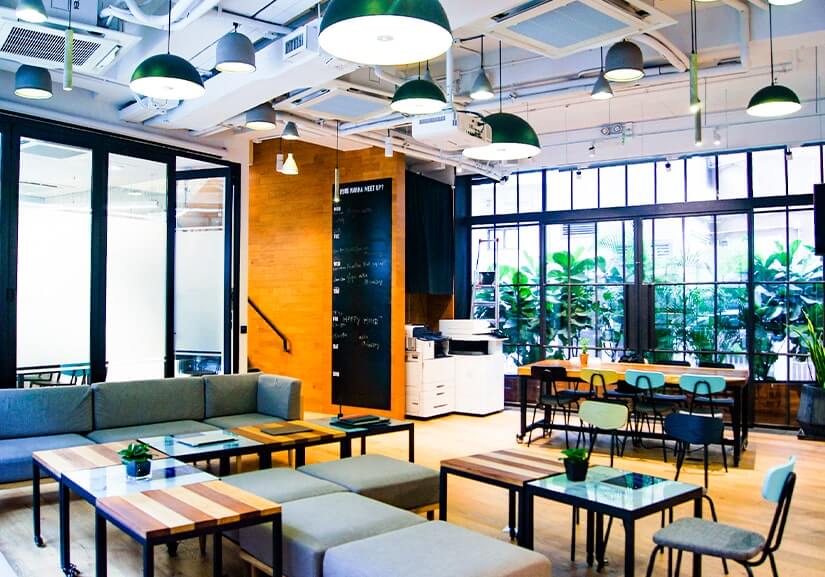Examples of Hot Desking and Hybrid Work
Hot Desking and hybrid work are today the purpose of many leading companies. These two models of space and personnel management have more and more followers, and what was seen as future space management is becoming more and more a reality for many companies.
We are facing a revolution in the business field, with three clear protagonists, digitization and new technologies that nurture companies, and the accelerator of changes that Covid-19 has led.
Since its modern conception (of individual and rigid modules), the office space has evolved towards a much more flexible, collaborative, and digitized model, through the implementation of instruments such as hot desking or teleworking, which have given a new meaning to the workspace.
However, this trend towards the digitization of leisure spaces has accelerated with the Covid-19 pandemic, which has forced us to rethink the conception of the workspace (physical and digital) putting well-being, safety, and health of the worker at its core.
Starting from this point, how should the new physical and digital spaces be in the healthcare paradigm in which we find ourselves today? And which of these tools will be maintained over time or how, this present, can help us lay the foundations for the new model of the office of the future?
If we look back two years ago, these working models seemed more for freelancers and yet, with the entry of new technologies, data in the cloud and the scourge of the Covid-19 pandemic, these working models have overshadowed the management of personnel departments.
What are the differences between Hot Desking and hybrid work?
Hot Desking is a model that focuses on the elimination of fixed spaces assigned to each employee, giving rise to free mobility. Hot Desking spaces are designed for the constant transfer of furniture between employees, giving rise to multipurpose desks and worktables, adapted to any employee regardless of their department or position. The employee acquires total management of his time, deciding when and where he goes in the office.
Hybrid work, in this work model, the employee and the company manage their time at their fixed job and at their remote workplace (teleworking). The workspaces continue as they are, however, their occupation decreases, favoring future renovations of spaces according to the daily movement of employees.
«At the middle of teleworking and face-to-face work, we find hybrid work.»
What do Hot Desking and hybrid work have in common?
Understanding the differences between the two, they also share many similarities, both for their implementation and for their daily management. Both work models provide employees with technological tools that allow their daily work and their integration with their workspaces.
For this purpose, it is necessary to integrate a software for the booking of desks, meeting rooms and common spaces, with the aim that both the company and its employees can manage the spaces in an optimal and flexible way.
This solution for the booking of corporate spaces remotely empowers the employee, providing him with the management of his workspace and the management of his time. Always respecting and promoting your flexibility and adaptability to your needs.
For this purpose, the knowledge of the space and the integration of the employee in it is essential. In most integrations, investments are required to adapt the physical space to the new work model.
Companies that implement Hot Desking or hybrid work?
North America Salesforce has implemented a labor policy in which its workers can choose between office work, hybrid work, or remote work. Carrying out reforms in its facilities to implement Hot desking, reducing the capacity of its offices by 50%.
The Swedish company Spotify has also opted for hybrid work by offering its employees the possibility of working some days at the office and other days at home.
Along the same lines, the Spanish company Telefónica, the Japanese multinational Canon, the French multinational Orange, the Asian multinational Huawei, and the North American multinational IBM have joined.
These companies have implemented different implementations to reduce capacity in their offices through shifts. They have also made renovations or modifications in their offices to make them more open and have adapted the meeting rooms for videoconferences, presentations, or physical meetings. In some companies, they have also established a rotating parking system for people who come to the office.
Microsoft, for its part, has given its employees the possibility to choose the work modality they want they can work all week in the offices, completely remotely or combine both in a hybrid modality.
Conclusion
Among the transformation processes caused by the confinement of Covid-19, concern for the health and well-being of people will be the main inheritance. That is why both the digital space (and the technology necessary for its development) and the physical space (and its configuration) must be the support to allow the transition.
- The health and well-being of the people in the center.
- People as consumers of the workspace.
- Work detached from physical space.
- The sustainable office.
- Creating personalized experiences.
- The dissolution of boundaries between the domestic space and the workspace.
- The physical infrastructure of offices with appropriate spaces.












